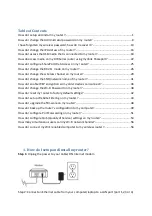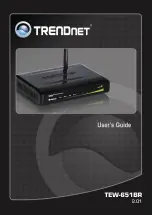
Wi-Fi Personal Bridge 150
User Manual
206
Class C networks are the smallest, only able to hold 254 hosts at most, but the total possible number
of class C networks exceeds 2 million (2,097,152 to be exact). LANs connected to the Internet are
usually class C networks.
Some important notes regarding IP addresses:
•
The class can be determined easily from field1:
field1 = 1-126:
Class A
field1 = 128-191:
Class B
field1 = 192-223:
Class C
(field1 values not shown are reserved for special uses)
•
A host ID can have any value except all fields set to 0 or all fields set to 255, as those values are
reserved for special uses.
Subnet masks
Definition
mask
A
mask
looks like a regular IP address, but contains a pattern of
bits that tells what parts of an IP address are the network ID and
what parts are the host ID: bits set to 1 mean "this bit is part of the
network ID" and bits set to 0 mean "this bit is part of the host ID."
Subnet masks
are used to define
subnets
(what you get after dividing a network into smaller pieces).
A subnet's network ID is created by "borrowing" one or more bits from the host ID portion of the
address. The subnet mask identifies these host ID bits.
For example, consider a class C network 192.168.1. To split this into two subnets, you would use
the subnet mask:
255.255.255.128
It's easier to see what's happening if we write this in binary:
11111111. 11111111. 11111111.10000000
As with any class C address, all of the bits in field1 through field3 are part of the network ID, but note
how the mask specifies that the first bit in field4 is also included. Since this extra bit has only two
values (0 and 1), this means there are two subnets. Each subnet uses the remaining 7 bits in field4
for its host IDs, which range from 1 to 126 hosts (instead of the usual 0 to 255 for a class C
address).
Similarly, to split a class C network into four subnets, the mask is:
255.255.255.192 or 11111111. 11111111. 11111111.11000000
The two extra bits in field4 can have four values (00, 01, 10, 11), so there are four subnets. Each
subnet uses the remaining six bits in field4 for its host IDs, ranging from 1 to 62.
Note
Sometimes a subnet mask does not specify any additional
network ID bits, and thus no subnets. Such a mask is called a
default subnet mask
. These masks are:
Class A:
255.0.0.0
Class B:
255.255.0.0
Class C:
255.255.255.0
These are called
default
because they are used when a network is
initially configured, at which time it has no subnets.
















































